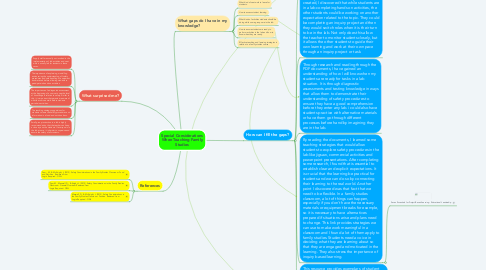Special Considerations When Teaching Family Studies
by Courtney Sestric


1. What surprised me?
1.1. Supply staff are usually not involved in the implementation of lab activities and seat work is usually left for students in these cases.
1.2. The importance of explaining, modelling and ensuring the understanding off safety procedures and safe handling of equipment and materials before allowing students to participate in hands on activities.
1.3. The importance of a diagnostic assessment at the beginning of a course to see the level of knowledge in relation to safety. Similar to this, it is important that parents are aware of what the course entails before students partake in activities.
1.4. The teaching strategy suggestions for students to learn the safety procedures and information in a food and nutrition class.
1.5. Small group instruction in a lab is highly recommended so that the teacher can keep a close eye on the students. If everyone is in the lab at once, it is harder to supervise and ensure the safety of all students.
2. What gaps do I have in my knowledge?
2.1. What kind of seat work to leave for students.
2.2. How to assess student learning.
2.3. What kinds of activities students should be doing while some groups are in the lab.
2.4. How to ensure students are ready to perform activities in the lab and how to know when they are ready.
2.5. Effective teaching and learning strategies in relation to a family studies course.
3. How can I fill the gaps?
3.1. Edugains provides many resources for educators in a variety of subject areas. When doing research, I was able to find Social Sciences and Humanities resources for secondary teachers. In thinking about seat work for students if a class is left with a supply teacher, it is essential that the work they are doing relates to what they are learning at the time and that it is meaningful. This website provides many lesson pan examples and activities that include assessments that as a new educator, I could tweak to fit the learning of my students at the time of a supply. I think it is a great resource to use as a new educator, as it provides a lot of information and ideas if you are stuck or not sur where to begin. You can use it in any way that fits your needs and your students needs.
3.1.1. Social Sciences and Humanities
3.2. After completing research and reviewing lesson plans that have already been created, I discovered that while students are in a lab completing hands on activities, the other students could be working on another expectation related to the topic. They could be completing an inquiry project and then they would switch roles when it is their turn to be in the lab. Not only does this allow the teacher to monitor students closely, but it allows the other students to guide their own learning and work at their own pace through an inquiry project or task.
3.3. Through research and reading through the PDF documents, I have gained an understanding of how I will know when my students are ready for tasks in a lab situation. It is through diagnostic assessments and testing knowledge in ways that allow them to demonstrate their understanding of safety procedures to ensure they have a good comprehension before they enter any lab. i could also have students practice with alternative materials or have them go through different processes before hand by imagining they are in the lab.
3.4. By reading the documents, I learned some teaching strategies that would allow students to explore safety procedures in the lab like jigsaw, commercial activities and powerpoint presentations. After completing some research, I found that is essential to establish clear and explicit expectations. It is crucial that the learning be practical for students and we can do so by connecting their learning to the real world. Another point I discovered was that fact that we need to be flexible. In a family studies classroom, a lot of things can happen, especially if you don't have the necessary materials or equipment breaks for example, so it is necessary to have alternatives prepared if situations arise and plans need to change. This link provides strategies we can use to make work meaningful in a classroom and I found a lot of them apply to family studies. Students need a voice in deciding what they are learning about so that they are engaged and motivated in the learning. They also stress the importance of inquiry based learning.
3.4.1. Seven Essentials for Project-Based Learning - Educational Leadership
3.5. This resource provides exemplars of student work in relation to the Ontario curriculum expectations. The document provides samples of level 1-4 work with a description of the task and prior knowledge and skills students would need to have before completing the activity. There are also examples of rubrics included with each task along with teacher notes of the four categories (knowledge/understanding, thinking/inquiry, communication/application) and comments and next steps. I can see myself using this document as a new family studies educator as it provides examples directly related to the Ontario curriculum of different assessments. Not having much teaching experience, assessment is one domain I still struggle with as it encompasses so many details, i think this will be extremely beneficial for me to refer to as I start my career.
3.5.1. https://collections.ola.org/mon/1000/10290800.pdf

